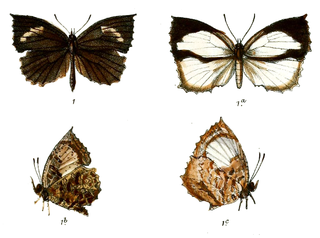Related Research Articles

Miletographa drumila, the crenulate darkie, is a small butterfly found in India, Burma, Thailand, Laos, Vietnam, and Yunnan (China) that belongs to the lycaenids or blues family.

Leipoxais is a genus of moths in the family Lasiocampidae. The genus was erected by William Jacob Holland in 1893.
Balacra jaensis is a moth of the family Erebidae. It was described by George Thomas Bethune-Baker in 1927. It is found in Cameroon and the Democratic Republic of the Congo.
Philenora aroa is a moth in the subfamily Arctiinae. It was described by George Thomas Bethune-Baker in 1904. It is found in New Guinea.
Teragra vogti is a moth in the family Cossidae. It is found in South Africa.
Tulaya staudingeri is a moth in the family Crambidae. It was described by George Thomas Bethune-Baker in 1893. It is found in Iran.
Eurrhyparodes multilinea is a moth in the family Crambidae. It was described by George Thomas Bethune-Baker in 1906. It is found in New Guinea.
Habrona alboplagata is a moth in the family Drepanidae. It was described by George Thomas Bethune-Baker in 1908. It is found in Papua New Guinea.
Cryptolechia transfossa is a moth in the family Depressariidae. It was described by Edward Meyrick in 1926. It is found in Peru.
Jana yokoana is a moth in the family Eupterotidae. It was described by George Thomas Bethune-Baker in 1927. It is found in Cameroon.

Cotana dubia is a moth in the family Eupterotidae. It was described by George Thomas Bethune-Baker in 1904. It is found in New Guinea.
Papuapterote styx is a moth in the family Eupterotidae. It was described by George Thomas Bethune-Baker in 1908. It is found in New Guinea.
Aroa yokoae is a moth in the family Erebidae. It was described by George Thomas Bethune-Baker in 1927. It is found in Cameroon.
Toosa batesi is a moth in the family Thyrididae. It was described by George Thomas Bethune-Baker in 1927. It is found in Cameroon.
Chrysopsyche yaundae is a moth in the family Lasiocampidae. It was described by George Thomas Bethune-Baker in 1927. It is found in Cameroon.
Mallocampa jaensis is a moth in the family Lasiocampidae. It was described by George Thomas Bethune-Baker in 1927. It is found in Cameroon.
Gastroplakaeis toroensis is a moth in the family Lasiocampidae. It was described by George Thomas Bethune-Baker in 1927. It is found in Uganda.
Filiola occidentale is a moth in the family Lasiocampidae. It was described by Strand in 1912. It is found in Cameroon, the Democratic Republic of Congo, Equatorial Guinea, Gabon, Ivory Coast and Nigeria.
Dichomeris habrochitona is a moth in the family Gelechiidae. It was described by Walsingham in 1911. It is found in Panama.

Sphingomorpha chlorea, the sundowner moth, is a species of moth in the family Erebidae that is native to Africa and southern Asia. The species was first described by Pieter Cramer in 1777. It is a fruit-piercing moth and a notorious pest in orchards. The fruit is pierced while performing a vertical and rhythmic movement of the head.
References
- ↑ Beccaloni, G.; Scoble, M.; Kitching, I.; Simonsen, T.; Robinson, G.; Pitkin, B.; Hine, A.; Lyal, C., eds. (2003). "Leipoxais batesi". The Global Lepidoptera Names Index . Natural History Museum . Retrieved May 18, 2018.
- ↑ Afro Moths
- ↑ Bethune-Baker, G. T. 1927. Descriptions of New Heterocera from Africa and the East. - Annals and Magazine of Natural History (9)20:321–334
| This article on a moth of the family Lasiocampidae is a stub. You can help Wikipedia by expanding it. |